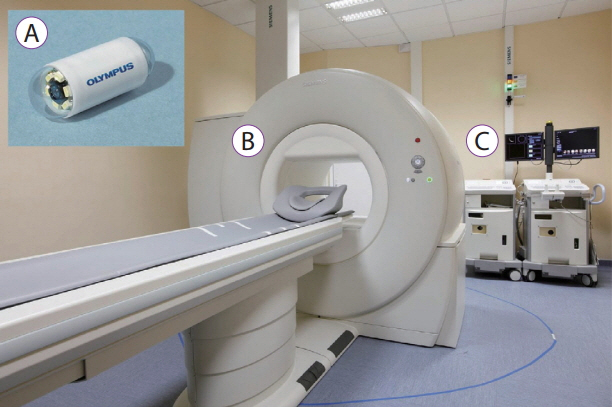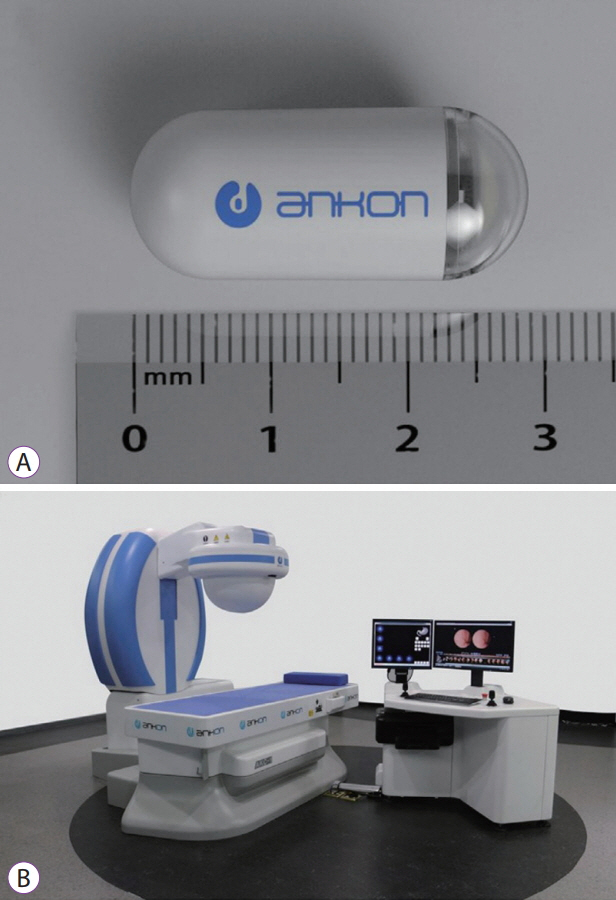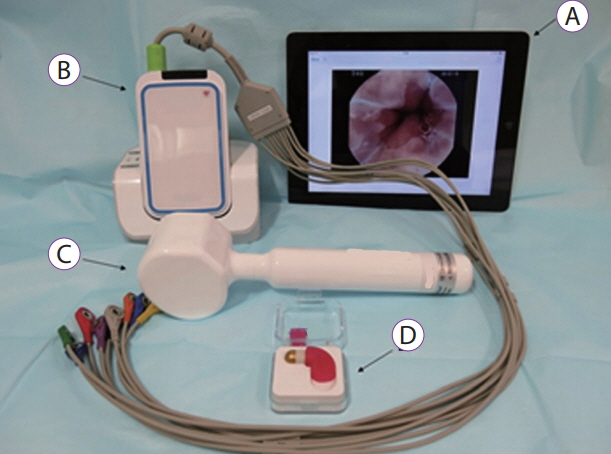Clin Endosc.
2018 Jul;51(4):323-328. 10.5946/ce.2018.092.
Evaluation of Gastric Disease with Capsule Endoscopy
- Affiliations
-
- 1Department of Internal Medicine, Kangwon National University School of Medicine, Chuncheon, Korea.
- 2Department of Internal Medicine, School of Medicine, Kyungpook National University, Kyungpook National University Hospital, Daegu, Korea.
- 3Department of Internal Medicine, Dongguk University, College of Medicine, Dongguk University Ilsan Hospital, Goyang, Korea. drlimyj@gmail.com
- KMID: 2419702
- DOI: http://doi.org/10.5946/ce.2018.092
Abstract
- The clinical indication for capsule endoscopy has expanded from small bowel evaluation to include esophagus or colon evaluation. Nevertheless, the role of capsule endoscopy in evaluation of the stomach is very limited because of the large volume and surface. However, efforts to develop an active locomotion system for capsule manipulation in detailed gastric evaluation are ongoing, because the technique is non-invasive, convenient, and safe, and requires no sedation. Studies have successfully reported gastric evaluation using a magnetic-controlled capsule endoscopy system. Advances in technology suggest that capsule endoscopy will have a major role not only in the evaluation of gastric disorders but also in the pathologic diagnosis, intervention, and treatment of any gastrointestinal tract disorder.
Keyword
MeSH Terms
Figure
Cited by 1 articles
-
A New Active Locomotion Capsule Endoscopy under Magnetic Control and Automated Reading Program
Dong Jun Oh, Kwang Seop Kim, Yun Jeong Lim
Clin Endosc. 2020;53(4):395-401. doi: 10.5946/ce.2020.127.
Reference
-
1. ASGE Technology Committee, Wang A, Banerjee S, et al. Wireless capsule endoscopy. Gastrointest Endosc. 2013; 78:805–815.
Article2. Sidhu R, Sanders DS, McAlindon ME. Does capsule endoscopy recognise gastric antral vascular ectasia more frequently than conventional endoscopy? J Gastrointestin Liver Dis. 2006; 15:375–377.3. Alkhormi AM, Memon MY, Alqarawi A. Gastric antral vascular ectasia: a case report and literature review. J Transl Int Med. 2018; 6:47–51.
Article4. Rey JF, Ogata H, Hosoe N, et al. Blinded nonrandomized comparative study of gastric examination with a magnetically guided capsule endoscope and standard videoendoscope. Gastrointest Endosc. 2012; 75:373–381.
Article5. Takahashi Y, Fujimori S, Toyoda M, et al. The blind spot of an EGD: capsule endoscopy pinpointed the source of obscure GI bleeding on the dark side of the pylorus. Gastrointest Endosc. 2011; 73:607–608.
Article6. Jun BY, Lim CH, Lee WH, et al. Detection of neoplastic gastric lesions using capsule endoscopy: pilot study. Gastroenterol Res Pract. 2013; 2013:730261.
Article7. Song HJ, Shim KN. Current status and future perspectives of capsule endoscopy. Intest Res. 2016; 14:21–29.
Article8. Peter S, Heuss LT, Beglinger C, Degen L. Capsule endoscopy of the upper gastrointestinal tract -- the need for a second endoscopy. Digestion. 2005; 72:242–247.
Article9. Delvaux M, Fassler I, Gay G. Clinical usefulness of the endoscopic video capsule as the initial intestinal investigation in patients with obscure digestive bleeding: validation of a diagnostic strategy based on the patient outcome after 12 months. Endoscopy. 2004; 36:1067–1073.
Article10. Kwack WG, Lim YJ. Current status and research into overcoming limitations of capsule endoscopy. Clin Endosc. 2016; 49:8–15.
Article11. Slawinski PR, Obstein KL, Valdastri P. Capsule endoscopy of the future: what’s on the horizon? World J Gastroenterol. 2015; 21:10528–10541.
Article12. De Falco I, Tortora G, Dario P, Menciassi A. An integrated system for wireless capsule endoscopy in a liquid-distended stomach. IEEE Trans Biomed Eng. 2014; 61:794–804.
Article13. Ciuti G, Caliò R, Camboni D, et al. Frontiers of robotic endoscopic capsules: a review. J Microbio Robot. 2016; 11:1–18.
Article14. Rahman I, Pioche M, Shim CS, et al. Magnetic-assisted capsule endoscopy in the upper GI tract by using a novel navigation system (with video). Gastrointest Endosc. 2016; 83:889–895. e1.15. Lien GS, Liu CW, Jiang JA, Chuang CL, Teng MT. Magnetic control system targeted for capsule endoscopic operations in the stomach--design, fabrication, and in vitro and ex vivo evaluations. IEEE Trans Biomed Eng. 2012; 59:2068–2079.16. Keller J, Fibbe C, Volke F, et al. Inspection of the human stomach using remote-controlled capsule endoscopy: a feasibility study in healthy volunteers (with videos). Gastrointest Endosc. 2011; 73:22–28.
Article17. Swain P, Toor A, Volke F, et al. Remote magnetic manipulation of a wireless capsule endoscope in the esophagus and stomach of humans (with videos). Gastrointest Endosc. 2010; 71:1290–1293.18. Qian Y, Wu S, Wang Q, et al. Combination of five body positions can effectively improve the rate of gastric mucosa’s complete visualization by applying magnetic-guided capsule endoscopy. Gastroenterol Res Pract. 2016; 2016:6471945.
Article19. Mahoney AW, Abbott JJ. Five-degree-of-freedom manipulation of an untethered magnetic device in fluid using a single permanent magnet with application in stomach capsule endoscopy. Int J Rob Res. 2016; 35:129–147.20. Yim S, Sitti M. Design and rolling locomotion of a magnetically actuated soft capsule endoscope. IEEE Trans Robot. 2012; 28:183–194.
Article21. Liao Z, Duan XD, Xin L, et al. Feasibility and safety of magnetic-controlled capsule endoscopy system in examination of human stomach: a pilot study in healthy volunteers. J Interv Gastroenterol. 2012; 2:155–160.
Article22. Keller H, Juloski A, Kawano H, et al. Method for navigation and control of a magnetically guided capsule endoscope in the human stomach. In : In: 2012 4th IEEE RAS & EMBS International Conference on Biomedical Robotics and Biomechatronics (BioRob); 2012 Jun 24-27; Rome, Italy. Piscataway Township (NJ). IEEE. 2012. p. 859–865.
Article23. Rey JF, Ogata H, Hosoe N, et al. Feasibility of stomach exploration with a guided capsule endoscope. Endoscopy. 2010; 42:541–545.
Article24. Denzer UW, Rösch T, Hoytat B, et al. Magnetically guided capsule versus conventional gastroscopy for upper abdominal complaints: a prospective blinded study. J Clin Gastroenterol. 2015; 49:101–107.25. Ciuti G, Donlin R, Valdastri P, et al. Robotic versus manual control in magnetic steering of an endoscopic capsule. Endoscopy. 2010; 42:148–152.
Article26. Liao Z, Hou X, Lin-Hu EQ, et al. Accuracy of magnetically controlled capsule endoscopy, compared with conventional gastroscopy, in detection of gastric diseases. Clin Gastroenterol Hepatol. 2016; 14:1266–1273. e1.27. Zou WB, Hou XH, Xin L, et al. Magnetic-controlled capsule endoscopy vs. gastroscopy for gastric diseases: a two-center self-controlled comparative trial. Endoscopy. 2015; 47:525–528.
Article28. Valdastri P, Webster RJ III, Quaglia C, Quirini M, Menciassi A, Dario P. A new mechanism for mesoscale legged locomotion in compliant tubular environments. IEEE Trans Robot. 2009; 25:1047–1057.
Article29. Quirini M, Menciassi A, Scapellato S, et al. Feasibility proof of a legged locomotion capsule for the GI tract. Gastrointest Endosc. 2008; 67:1153–1158.
Article30. Quirini M, Menciassi A, Scapellato S, Stefanini C, Dario P. Design and fabrication of a motor legged capsule for the active exploration of the gastrointestinal tract. IEEE ASME Trans Mechatron. 2008; 13:169–179.
Article31. Gorini S, Quirini M, Menciassi A, Pernorio G, Stefanini C, Dario P. SMA-based actuator for a legged endoscopic capsule. In : In: The First IEEE/RAS-EMBS International Conference on Biomedical Robotics and Biomechatronics; 2006 Feb 20-22; Pisa, Italy. Piscataway Township (NJ). IEEE. 2006. p. 443–449.32. Park S, Park H, Park S, Kim B. A paddling based locomotive mechanism for capsule endoscopes. Journal of Mechanical Science and Technology. 2006; 20:1012–1018.
Article33. Kim HM, Yang S, Kim J, et al. Active locomotion of a paddling-based capsule endoscope in an in vitro and in vivo experiment (with videos). Gastrointest Endosc. 2010; 72:381–387.
Article34. Kim B, Lee S, Park JH, Park J-O. Design and fabrication of a locomotive mechanism for capsule-type endoscopes using shape memory alloys (SMAs). IEEE ASME Trans Mechatron. 2005; 10:77–86.
Article35. Kim B, Park S, Jee CY, Yoon S-J. An earthworm-like locomotive mechanism for capsule endoscopes. In : In: 2005 IEEE/RSJ International Conference on Intelligent Robots and Systems; 2005 Aug 2-6; Edmonton, Canada. Piscataway Township (NJ). IEEE. 2005. p. 2997–3002.
Article36. Morita E, Ohtsuka N, Shindo Y, et al. In vivo trial of a driving system for a self-propelling capsule endoscope using a magnetic field (with video). Gastrointest Endosc. 2010; 72:836–840.
Article37. Tortora G, Valdastri P, Susilo E, et al. Propeller-based wireless device for active capsular endoscopy in the gastric district. Minim Invasive Ther Allied Technol. 2009; 18:280–290.
Article38. Carta R, Tortora G, Thoné J, et al. Wireless powering for a self-propelled and steerable endoscopic capsule for stomach inspection. Biosens Bioelectron. 2009; 25:845–851.
Article39. Gorlewicz JL, Battaglia S, Smith BF, et al. Wireless insufflation of the gastrointestinal tract. IEEE Trans Biomed Eng. 2013; 60:1225–1233.
Article40. Pasricha T, Smith BF, Mitchell VR, et al. Controlled colonic insufflation by a remotely triggered capsule for improved mucosal visualization. Endoscopy. 2014; 46:614–618.
Article41. Ching HL, Hale MF, McAlindon ME. Current and future role of magnetically assisted gastric capsule endoscopy in the upper gastrointestinal tract. Therap Adv Gastroenterol. 2016; 9:313–321.
Article42. Imagawa H, Oka S, Tanaka S, et al. Improved detectability of small-bowel lesions via capsule endoscopy with computed virtual chromoendoscopy: a pilot study. Scand J Gastroenterol. 2011; 46:1133–1137.
Article43. Matsumura T, Arai M, Sato T, et al. Efficacy of computed image modification of capsule endoscopy in patients with obscure gastrointestinal bleeding. World J Gastrointest Endosc. 2012; 4:421–428.
Article44. Park S, Koo K-I, Bang SM, Park JY, Song SY, Cho D. A novel microactuator for microbiopsy in capsular endoscopes. J Micromech Microeng. 2008; 18:025032.
Article45. Kong K-C, Cha J, Jeon D, Cho D-I. A rotational micro biopsy device for the capsule endoscope. In : In: 2005 IEEE/RSJ International Conference on Intelligent Robots and Systems; 2005 Aug 2-6; Edmonton, Canada. Piscataway Township (NJ). IEEE. 2005. p. 1839–1843.
Article46. Valdastri P, Quaglia C, Susilo E, et al. Wireless therapeutic endoscopic capsule: in vivo experiment. Endoscopy. 2008; 40:979–982.
Article47. Swain P. The future of wireless capsule endoscopy. World J Gastroenterol. 2008; 14:4142–4145.
Article48. Rahman I, Kay M, Bryant T, et al. Optimizing the performance of magnetic-assisted capsule endoscopy of the upper GI tract using multiplanar CT modelling. Eur J Gastroenterol Hepatol. 2015; 27:460–466.
Article




